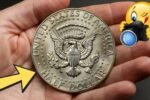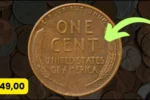The Lincoln Wheat Penny Valued at $21 Million, Still in Circulation: The Lincoln Wheat Penny, a small coin with a big legacy, has been a collector’s favorite since it was first minted in 1909. But whispers of a super rare version, possibly worth $21 million, have collectors and everyday folks checking their change. With Abraham Lincoln’s face on one side and wheat stalks on the other, these pennies were made until 1958. Most are worth just a cent, but rare ones, like the fabled 1943 Bronze Penny, have sold for millions. Could one of these treasures still be out there, hiding in your wallet or a dusty jar?
A Coin That Tells a Story
The Lincoln Wheat Penny was created to celebrate Lincoln’s 100th birthday, making it the first U.S. coin to feature a real person. Designed by Victor David Brenner, it has Lincoln’s profile and wheat stalks symbolizing prosperity. During World War II, copper was scarce, so most 1943 pennies were made of steel. By mistake, a few were struck in bronze, and these are now among the rarest coins in the world. One 1943 Bronze Penny sold for $1.7 million in 2010, and experts say its value could now reach $21 million due to its rarity and demand.
The Rare Bicentennial Quarter Valued at $2.5 Billion, Still in Circulation
Why Is It Worth So Much?
The value of a Lincoln Wheat Penny skyrockets because of rarity, condition, and minting errors. The 1943 Bronze Penny is a star because only a handful—estimated at 10 to 15—exist. During the war, copper was saved for military use, making these bronze errors a fluke. Coins in mint condition, with sharp details and no wear, fetch the highest prices. Other rare pennies, like the 1909-S VDB or 1914-D, can also sell for hundreds of thousands. Mint marks (like “S” or “D”) or their absence can make a huge difference in value.
How to Find a Million-Dollar Penny
Want to check if you’ve got a valuable penny? Here’s what to look for:
- Check the date: Look for “1943” with no mint mark or a rare mint mark like “D” or “S.”
- Test the material: A 1943 bronze penny won’t stick to a magnet, unlike steel ones. It weighs about 3.11 grams, heavier than steel’s 2.7 grams.
- Inspect condition: Clear, unworn details mean higher value.
- Look for errors: Double strikes or misprints, like the 1955 Double Die, add worth.
If you find a suspect penny, don’t clean it—cleaning lowers its value. Have it graded by pros like PCGS or NGC to confirm its authenticity.
| Rare Lincoln Wheat Pennies | Estimated Value | Why It’s Rare |
|---|---|---|
| 1943 Bronze Penny | Up to $21M | Minted in copper by mistake during WWII |
| 1909-S VDB Penny | Up to $100,000 | First year, low mintage, designer’s initials |
| 1914-D Penny | Up to $200,000 | Only 1.2 million made at Denver Mint |
Is It Still Out There?
The idea of a $21 million penny still in circulation sounds like a dream, but it’s not impossible. People have found rare coins in change or old collections, often unaware of their worth. The 1943 Bronze Penny looks like a regular penny at a glance, so it could easily be spent or overlooked. While claims of $100 million pennies are myths, a 1943 Bronze Penny could still surface. Next time you get change, take a second look—you might just spot a life-changing coin hiding in plain sight.
FAQs: The Lincoln Wheat Penny Valued at $21 Million
Q1: What is the $21 million Lincoln Wheat Penny?
A: It refers to an extremely rare and valuable version of the Lincoln Wheat Penny, rumored to be worth up to $21 million due to unique minting errors or historical significance.
Q2: Is the $21 million penny real?
A: While no single Lincoln Wheat Penny has sold for $21 million publicly, certain rare versions (like the 1943 bronze penny) have fetched hundreds of thousands to over a million dollars at auctions. The $21 million figure is likely an exaggerated or speculative claim.
Q3: Why is this penny so valuable?
A: The value comes from minting errors, extremely limited quantities, or unique historical circumstances, such as being struck in the wrong metal or from a rare mint year.



